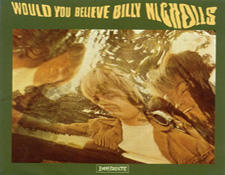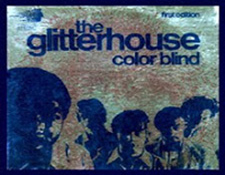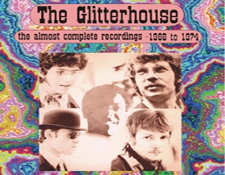It’s the time of year for saving money!
The stories of the two albums I’m reviewing here are incredibly similar. Both tales occur in the psychedelic late 1960s, one in New York, the other in swingin’ London. Both projects were driven by producers concerned with keeping pace with current trends. Both efforts resulted in albums which bear a remarkable sonic paisley pop resemblance, one revered and highly collectible, the other virtually unknown apart from a select few (like me) who have discovered it.
 Both records were also doomed to obscurity by their producers for reasons not entirely known, enjoying (if you will) very limited releases back in their day. The records in question are Color Blind by The Glitterhouse and Would You Believe by Billy Nichols. I recently came across a used copy of the Billy Nichols album that had been reissued on CD in 1999 and even it –now out of print — is fetching collectors pricing upwards of $50 on eBay and Amazon! I got my copy for $2.99! Reading the liner notes, that prompted me to write this piece for you, Dear Readers, hopeful purveyors of fine (if obscure) rarities.
Both records were also doomed to obscurity by their producers for reasons not entirely known, enjoying (if you will) very limited releases back in their day. The records in question are Color Blind by The Glitterhouse and Would You Believe by Billy Nichols. I recently came across a used copy of the Billy Nichols album that had been reissued on CD in 1999 and even it –now out of print — is fetching collectors pricing upwards of $50 on eBay and Amazon! I got my copy for $2.99! Reading the liner notes, that prompted me to write this piece for you, Dear Readers, hopeful purveyors of fine (if obscure) rarities.
Would You Believe
The Billy Nicholls album is a fascinating story which, in short, involves a young lad of 16 somehow getting his demos to George Harrison which ultimately led to him getting a staff writing position with Andrew Loog Oldham (of The Rolling Stones fame) who had recently started his own label, Immediate Records. Oldham was apparently eager to create a British answer to the harmonious sounds of The Beach Boys and other West Coast sunshine pop stars like The Mamas and The Papas. Nicholls was his solution — it was very much a scenario of the right songs and the right voice appearing at the right place at the right time. Fast forward, Nicholls records a twee but lovely album of post Summer of Love psychedelic pop backed by The Small Faces, only to have the album shelved after 100 promotional copies were pressed (ensuring it would become an ultimate holy grail — if you will — among fans of British pop psychedelia, original pressings commanding thousands of dollars from collectors).
The music on Would You Believe is less like The Beach Boys and more like — and I mean this in a good way — The Partridge Family or The Cowsills, with plenty of harpsichords, string sections and nice harmonies. The comparison to the Beach Boys on the CD reissue liner notes is perhaps misguided since there is little of the densely-layered, Spector-esque invention that went on in Brian Wilson’s productions. Why was it shelved? Apparently, no one really knows. With the benefit of 20/20 hindsight, it is easy to see that this album — along with The Kinks’ Village Green Preservation Society — was a record just a moment out of step with its times given the eventual release timing in 1968. Had it come out in 1967, perhaps it would have had a chance, but by 1968 the Vietnam war was escalating, riots were happening and pop music took on a decidedly harder edged, what with Hendrix letting his freak flag fly, The Who turning up the volume to 11 and “heavy” bands like Blue Cheer and Iron Butterfly rising up in the ranks (and Billboard charts). So perhaps it is understandable why the record was not really issued … well, that and the fact that the label was apparently on the brink of bankruptcy!
Would You Believe is a fine collection that reminds me at times of The Left Banke with its gorgeous string-laden harmony hits “Walk Away Renee” and “Pretty Ballerina.” With groovy songs like “Girl From New York” and “London Social Degree” (L.S.D. , get it?), this first effort by Billy Nicholls is well worth checking out if you can find a copy. And the good news is Nicholls went on to make other recordings including appearances on Pete Townshend’s first solo album Who Came First as well as singing back up vocals on The Who’s Who Are You? Later he toured with The Who as a back up singer and even served as their music director!
The tale behind The Glitterhouse is almost as sordid, and the resultant obscurity more frustrating Like Mr. Oldham, New York based producer Bob Crewe — hit producer of The Four Seasons! — was seeking an act that could establish his artistic presence alongside more progressive productions emanating out of Britain by the likes of The Beatles. He found a band from Long Island called The Glitterhouse, with its unconventional (for the period) line-up featuring Mike Gayle, an African American lead singer and main songwriter. The group was hired and put on salary as recording commenced at A&R Studios in New York, engineered by the legendary Roy Cicala and Shelly Yakus (who were working at night on the debut album by The Band!). Crewe drove the production and overall sonic vision for the group’s songs (vocal arrangements, etc.). The group was told not to perform live at that time as there was to be a grand unveiling which would ideally take the world by surprise.
The best laid plans, as they say…
Along the way, the band members were brought in to sing vocals on the soundtrack to a new film starring Jane Fonda — yes, the cult classic camp SciFi flick, Barbarella! — which was apparently stirring a lot of buzz back in the day; it was thus seemingly going to be something of a “one-two punch” (according to reissue liner notes) with Barbarella coming out first followed by the full on album by The Glitterhouse. Alas, before the band knew it, everything stalled. The soundtrack album and single didn’t do anything. By the time the real Glitterhouse album was issued, the powers that be had lost interest and in short, nothing really happened. A single made the Top 50 in New York, but there was little publicity and the band didn’t get to go on the road to promote the record.
]]>Released on Crewe’s Dynovoice subsidiary label of Dot Records — a label which had put out hit records by Mitch Ryder, The Toys as well as Crewe’s own smash hit “Music To Watch Girls By” — the album looked fantastic with its silver and blue foil cover art and enthusiastic liner notes from then NY-based DJ on WNEW-FM, Rosko. But that apparently wasn’t enough. Four weeks after the album’s failed release the band were taken off salary.
 Disillusioned and discouraged, the band soon split up. It boggles the mind as to why this band that had believed so passionately in their music and worked so earnestly and hard for the producers would be treated this way. Especially when you listen to this obviously joyous recording which Crewe shaped into a paisley pop gem that no one really got to hear.
Disillusioned and discouraged, the band soon split up. It boggles the mind as to why this band that had believed so passionately in their music and worked so earnestly and hard for the producers would be treated this way. Especially when you listen to this obviously joyous recording which Crewe shaped into a paisley pop gem that no one really got to hear.
I myself never would have heard about it had I not found a copy of the then cut-out LP in a 3-for-$1 bargain bin in an upstate New York “5- and 10-cent” store (‘member them?) one Summer in the mid 70s. For 33 cents, it looked too cool to pass up! This album soon became a favorite sunshine pop listen for me, with its ever-so-groovy and trippy fantasy titles like “Princess of the Gingerland,” “Sassafras and Cinnamon” and “Tinkerbell’s Mind.”
For some 20 subsequent years I had no idea about the history on this mysterious band until a trip to London in 1999 and a fortuitous visit to a record store revealed an entire section dedicated to the band (they had several copies of the album). The store clerk there was very into The Glitterhouse and it was from him I learned about the Barbarella connection. Years later via the Interwebs I discovered the website belonging to one of the original band members, Moogy Klingman (you can’t make up names like this folks!). There, Moogy was selling CD-R reissues of the album, transferred off one of his pristine LP copies. The CD-R came complete with comprehensive liner notes telling the whole sordid Glitterhouse story and includes rare bonus tracks such as early singles and reunion demos from 1974. Moogy, had gone on to become the original keyboardist in Todd Rundgren’s first Utopia! The band also included Joel “Bishop” O’Brien who went on to play drums with James Taylor and Carol King, among many others.
 Like The Left Banke and Billy Nichols’ records, The Glitterhouse has its twee innocent faux psychedelic moments that put it this side of The Cowsills (think “The Rain, The Park, and Other Things”) in terms of overall sound. Yet The Glitterouse were a real rock band and they could play, so there are cool drum breaks, groovy guitar solos, swirling organ swells and more. To my ear, this album should be up there with the Billy Nichols album as far as fans of sunshine pop go. But you don’t have to spend $50 for a used CD at this point in time to experience this gem — in fact, you can find original LP copies on eBay now for under $15.
Like The Left Banke and Billy Nichols’ records, The Glitterhouse has its twee innocent faux psychedelic moments that put it this side of The Cowsills (think “The Rain, The Park, and Other Things”) in terms of overall sound. Yet The Glitterouse were a real rock band and they could play, so there are cool drum breaks, groovy guitar solos, swirling organ swells and more. To my ear, this album should be up there with the Billy Nichols album as far as fans of sunshine pop go. But you don’t have to spend $50 for a used CD at this point in time to experience this gem — in fact, you can find original LP copies on eBay now for under $15.
If, like me, you like some periodic pop rock that is chockfull of sparkly sunshine, definitely keep an eye out for these fun lost recordings.
Mark Smotroff is a freelance writer and avid music collector who has worked for many years in marketing communications for the consumer electronics, pro audio and video games industries, serving clients including DTS, Sega, Sony, Sharp, AT&T and many others. www.smotroff.com Mark has written for EQ Magazine, Mix Magazine, Goldmine/DISCoveries Magazine, BigPictureBigSound.com, Sound+Vision Magazine and HomeTechTell.com. He is also a musician / composer whose songs have been used in TV shows such as Smallville and Men In Trees as well as films and documentaries. www.ingdom.com Mark is currently rolling out a new musical he’s written: www.dialthemusical.com.







